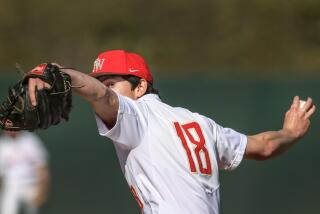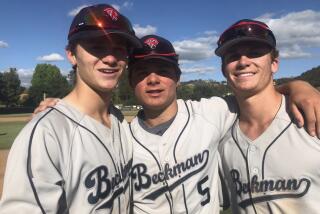Mariners Arm Themselves With ‘Big Unit’ Clone
- Share via
A draft notebook (or, How can all those kids afford BMWs?):
TWIN PEAKS
Can Ryan Anderson, the Seattle Mariners’ No. 1 selection in Tuesday’s amateur draft and the 19th player selected in the first round, become another Randy Johnson?
A tall order indeed, but that’s what Roger Jongewaard, director of scouting and player development, said about the 17-year-old pitcher from Divine Child High School in Dearborn, Mich.
Anderson, like Johnson, is left-handed and 6 feet 10, and people in Dearborn call him “the Young Unit,” a spinoff from Johnson’s “Big Unit.”
“I saw Randy in high school, and this kid is more advanced, a little bigger and more athletic than Randy was,” Jongewaard said.
“Our scout there [Ken Madeja] says he’s the best high school pitcher he’s ever seen, and that says a lot because he’s a guy who signed John Smoltz and scouted pitchers like Frank Tanana and Jim Abbott from that area.
“It’s always a gamble, but we thought this was a good one.”
Anderson throws in the mid-90s and had 133 strikeouts in 51 innings in a league in which two strikes are out and three balls yield a walk.
Many considered him a natural for the hometown Detroit Tigers, who had the No. 1 pick, but the Tigers ultimately selected Rice reliever Matt Anderson in the belief that the college pitcher was much closer to being ready and capable of filling a glaring need.
There were also some character and maturity issues involving Ryan Anderson that concerned the Tigers and other teams--he had reportedly been involved in a shoplifting incident and had some disciplinary problems at school--and those issues contributed to his fall from a possible No. 1 to No. 19.
Anderson, through advisors Alan and Randy Hendricks, also had put out the word that if he wasn’t drafted by the Tigers, he preferred being drafted by the Mariners, Johnson being his idol, or one of the 1998 expansion teams.
Johnson joined the Mariners out of USC but still experienced growing pains, on and off the field.
That experience may better prepare the Mariners for Anderson, who still has to sign but said he was looking forward to “a chance to pitch with Randy some day.”
Twin Peaks, offered General Manager Woody Woodward. Twin Towers, said Johnson, who added he was flattered to be admired by Anderson but that it was also “kind of scary.”
“I wouldn’t want anyone to be like me,” he said. “My slogan is not, ‘Be Like Randy.’ ”
Perhaps, but that won’t deter Anderson, who is 16 years younger than his idol and may have to be on the fast track if he wants to be a teammate.
Johnson’s contract expires after the 1998 season. He has rebounded big from back surgery but won’t say what his plans are beyond ’98.
He did say that if Anderson winds up in the same rotation, “he’s going to have to change his nickname. There’s only room for one Big Unit, although I kind of like Puppy Unit.”
THE BORAS FACTOR
Agent Scott Boras refused to use the dreaded C word--collusion--about the clubs’ approach to the first round but did say there was “a hint of collective reasoning.”
Signability and affordability in the wake of last year’s $10-million free-agent signings of Travis Lee and Matt White dominated the approach, as expected, affecting what players were selected and when.
“It’s supposed to be a negotiated entry [into professional baseball for the amateur player], but it’s not,” Boras said. “Unless high school players, in particular, were willing to pre-fix their price [before the draft], they weren’t going to go high. What the clubs have done is escalate the value of lesser talent [by drafting it ahead of potentially better but higher-priced players].”
Some also viewed it as a backlash against Boras, who represented two of the four players declared free agents after last year’s draft because of technical violations by the clubs that had drafted them. Boras has a reputation for aggressive and often contentious negotiations. He, however, disagreed with the backlash view.
He had three players selected in the first round--Florida State outfielder J.D. Drew, No. 2 by Philadelphia; Stanford pitcher Kyle Peterson, No. 13 by Milwaukee; and Louisiana State shortstop Brandon Larson, No. 14 by Cincinnati.
Three other of his potential first-rounders dropped to the second round--Florida high school pitcher Rick Ankiel, Hawaii high school catcher Dane Sardinha and Fresno State pitcher Jeff Weaver.
“The three best high school players in the draft were Ankiel, Anderson and [outfielder] Darnell McDonald,” Boras said. “All are represented by different people and all dropped substantially in the draft. This had nothing to do with the representative.”
There’s some validity to that. Boras told the Phillies before the draft that it would take $10 million or more to sign Drew, and the Phillies still made him the second player selected.
Club President Bill Giles is now saying the Phillies won’t disrupt the system, that Lee and White were technical aberrations last year, and that he is thinking of a bonus closer to the $2 million that the No. 1 pick of ‘96, pitcher Kris Benson, received from the Pittsburgh Pirates.
If that’s the case, well, then it’s likely that there will be some contentious negotiations, although Drew’s options seem limited to a senior season at Florida State or a protracted court challenge of the draft system.
THE KEYS TO THOSE BMWS
Five of the first-round players had signed through Friday, all high school players in what appeared to be the pre-fixed deals Boras described.
Outfielder Vernon Wells, picked No. 5 by Toronto, got $1.6 million, as did Baldwin Park High first baseman J.J. Davis, No. 8 by Pittsburgh.
Pitcher Aaron Akin, No. 12 by Florida, got $1.1 million; pitcher Mark Mangum, No. 18 by Colorado, got $875,000, and pitcher Jason Standridge, No. 31 by Tampa Bay, got $700,000.
More to Read
Go beyond the scoreboard
Get the latest on L.A.'s teams in the daily Sports Report newsletter.
You may occasionally receive promotional content from the Los Angeles Times.










